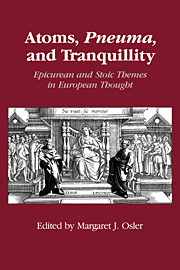Book contents
- Frontmatter
- Contents
- List of contributors
- Acknowledgments
- Introduction
- 1 Ethics and logic in Stoicism
- 2 Medieval connectives, Hellenistic connections: the strange case of propositional logic
- 3 Stoic psychotherapy in the Middle Ages and Renaissance: Petrarch's De remediis
- 4 Alonso de Cartagena and John Calvin as interpreters of Seneca's De clementia
- 5 The Epicurean in Lorenzo Valla's On Pleasure
- 6 Seneca's role in popularizing Epicurus in the sixteenth century
- 7 Stoic contributions to early modern science
- 8 Fortune, fate, and divination: Gassendi's voluntarist theology and the baptism of Epicureanism
- 9 Epicureanism and the creation of a privatist ethic in early seventeenth-century France
- 10 Robert Boyle on Epicurean atheism and atomism
- 11 Stoic and Epicurean doctrines in Newton's system of the world
- 12 Locke, Willis, and the seventeenth-century Epicurean soul
- 13 The Epicurean new way of ideas: Gassendi, Locke, and Berkeley
- 14 The Stoic legacy in the early Scottish Enlightenment
- Index
3 - Stoic psychotherapy in the Middle Ages and Renaissance: Petrarch's De remediis
Published online by Cambridge University Press: 13 November 2009
- Frontmatter
- Contents
- List of contributors
- Acknowledgments
- Introduction
- 1 Ethics and logic in Stoicism
- 2 Medieval connectives, Hellenistic connections: the strange case of propositional logic
- 3 Stoic psychotherapy in the Middle Ages and Renaissance: Petrarch's De remediis
- 4 Alonso de Cartagena and John Calvin as interpreters of Seneca's De clementia
- 5 The Epicurean in Lorenzo Valla's On Pleasure
- 6 Seneca's role in popularizing Epicurus in the sixteenth century
- 7 Stoic contributions to early modern science
- 8 Fortune, fate, and divination: Gassendi's voluntarist theology and the baptism of Epicureanism
- 9 Epicureanism and the creation of a privatist ethic in early seventeenth-century France
- 10 Robert Boyle on Epicurean atheism and atomism
- 11 Stoic and Epicurean doctrines in Newton's system of the world
- 12 Locke, Willis, and the seventeenth-century Epicurean soul
- 13 The Epicurean new way of ideas: Gassendi, Locke, and Berkeley
- 14 The Stoic legacy in the early Scottish Enlightenment
- Index
Summary
The course of Stoicism in Italy in the Middle Ages and the Renaissance, from about 1350 to 1550, has not by any means been fully charted. It is generally agreed that a renewal of Latin Stoicism there gathered momentum with the humanist Francesco Petrarca (1304–1374) and was bound up with his desire to write philosophy in an elegant Latin that educated laymen, as well as professional scholars, could understand. The kind of letters Petrarch wrote, in fact, are close in spirit to the urbane letters of moral and spiritual guidance written by the Roman Stoic Seneca to his younger friend and disciple Lucilius – intimate and moving, yet instructive. Petrarch's renewal of Stoicism moved along two main paths. The first was his presentation, in De vita solitaria and De otio religioso, of a Stoic / Christian way of life in which cultivation of the scholarly life and ethical perfection are one. Petrarch's model looks remarkably like Seneca's sapiens – that self-sufficient sage, as rare to find as the phoenix, delineated in the Dialogues. The second was Petrarch's elaboration of Stoic psychotherapy in his huge compendium, De remediis utriusque fortunae, based on a mutilated work of similar name attributed to Seneca. The principles of psychotherapy that Petrarch advocates, he tells us explicitly in De remediis and in his more intimate Secretum, are derived mainly from Cicero's Tusculans, the richest Latin source on the subject, and also from Seneca's De tranquillitate animi and the Letters to Lucilius.
- Type
- Chapter
- Information
- Atoms, Pneuma, and TranquillityEpicurean and Stoic Themes in European Thought, pp. 39 - 66Publisher: Cambridge University PressPrint publication year: 1991
- 9
- Cited by



